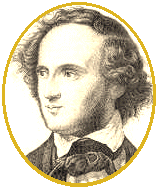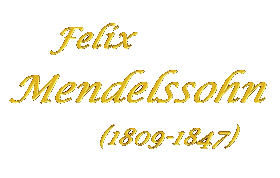 As an adolescent, Felix's works were often performed at home with a private orchestra for the associates of his wealthy parents amongst the intellectual
elite of Berlin. Mendelssohn wrote his first twelve symphonies in his early teens (more specifically, from ages twelve to fourteen).
These works were ignored for over a century, but are now recorded and heard occasionally in concerts. At fifteen he wrote his first acknowledged symphony
for full orchestra, his opus 11 in C minor in 1824. At the age of sixteen he wrote his String Octet in E Flat Major, the first work which showed the
full power of his genius, which, together with his overture to Shakespeare's A Midsummer Night's Dream, which he wrote a year later, was the best known
of his early works. (He wrote incidental music for the play in 1842, including the famous Wedding March). 1827 saw the premiere - and sole performance
in his lifetime - of his opera, Die Hochzeit des Camacho. The failure of this production left him disinclined to venture into the genre again;
he later toyed for a while in the 1840s with libretto by Eugene Scribe based on Shakespeare's The Tempest, but rejected it as unsuitable.
As an adolescent, Felix's works were often performed at home with a private orchestra for the associates of his wealthy parents amongst the intellectual
elite of Berlin. Mendelssohn wrote his first twelve symphonies in his early teens (more specifically, from ages twelve to fourteen).
These works were ignored for over a century, but are now recorded and heard occasionally in concerts. At fifteen he wrote his first acknowledged symphony
for full orchestra, his opus 11 in C minor in 1824. At the age of sixteen he wrote his String Octet in E Flat Major, the first work which showed the
full power of his genius, which, together with his overture to Shakespeare's A Midsummer Night's Dream, which he wrote a year later, was the best known
of his early works. (He wrote incidental music for the play in 1842, including the famous Wedding March). 1827 saw the premiere - and sole performance
in his lifetime - of his opera, Die Hochzeit des Camacho. The failure of this production left him disinclined to venture into the genre again;
he later toyed for a while in the 1840s with libretto by Eugene Scribe based on Shakespeare's The Tempest, but rejected it as unsuitable.
In 1829 Mendelssohn paid his first visit to England, where Moscheles, already settled in London, introduced him to influential musical circles. Felix had a great success, conducting his First Symphony and playing in public and private concerts. On subsequent visits he met with Queen Victoria and her musical husband Prince Albert, both of whom were great admirers of his music. In the course of ten visits to Britain during his life he won a strong following, and the country inspired two of his most famous works, the overture Fingal's Cave (also known as the Hebrides Overture) and the Scottish Symphony (Symphony No. 3). His oratorio Elijah was premiered in Birmingham on 26 August 1846.
In 1835 Mendelssohn was appointed as conductor of the Leipzig Gewandhaus Orchestra. This appointment was extremely important for him; he felt himself to be a German and wished to play a leading part in his country's musical life. Despite efforts by the king of Prussia to lure him to Berlin, Mendelssohn concentrated on developing the musical life of Leipzig and in 1843 he founded the Leipzig Conservatory, where he successfully persuaded Moscheles and Robert Schumann to join him.
 Mendelssohn's personal life was conventional. His marriage to Cécile Jeanrenaud in March of 1837 was very happy and the couple had five children.
Felix was an accomplished painter in water-colour, and his enormous correspondence shows that he could also be a witty writer (in both German and
English - and sometimes accompanied by humorous sketches and cartoons in the text).
Mendelssohn's personal life was conventional. His marriage to Cécile Jeanrenaud in March of 1837 was very happy and the couple had five children.
Felix was an accomplished painter in water-colour, and his enormous correspondence shows that he could also be a witty writer (in both German and
English - and sometimes accompanied by humorous sketches and cartoons in the text).
Mendelssohn suffered from bad health in the final years of his life, probably aggravated by nervous problems and overwork, and he was greatly distressed by the death of his sister Fanny in May 1847. Felix Mendelssohn died later that same year after a series of strokes, on November 4, 1847, in Leipzig.
Mendelssohn was deeply influenced by the music of Johann Sebastian Bach. He arranged and conducted a performance in Berlin of Bach's St. Matthew Passion.
The orchestra and choir were provided by the Berlin Singakademie of which Zelter was the prinicpal conductor. The success of this performance
(the first since Bach's death in 1750) was an important element in the revival of J.S. Bach's music in Germany and, eventually, throughout Europe.
It earned Mendelssohn widespread acclaim at the age of twenty.
Mendelssohn also revived interest in the work of Franz Schubert. He conducted the premiere of Schubert's Ninth Symphony in 1839, more than a decade
after the composer's death.
Throughout his life Mendelssohn was wary of the more radical musical developments undertaken by some of his contemporaries. He was generally on friendly, if somewhat cool, terms with the likes of Berlioz, Liszt, and Meyerbeer, but in his letters expresses his frank disapproval of their works. In particular, he seems to have regarded Paris and its music with the greatest of suspicion, with an almost Puritan distaste. This conservative strain in Mendelssohn, which set him apart from some of his more flamboyant contemporaries, bred a similar condescension on their part toward his music.
 The young Mendelssohn was greatly influenced in his childhood by the music of Bach, Beethoven and Mozart and these can all be seen,
albeit often rather crudely, in the twelve early 'symphonies,' mainly written for performance in the Mendelssohn household and not published or
publicly performed until long after his death.
The young Mendelssohn was greatly influenced in his childhood by the music of Bach, Beethoven and Mozart and these can all be seen,
albeit often rather crudely, in the twelve early 'symphonies,' mainly written for performance in the Mendelssohn household and not published or
publicly performed until long after his death.
His astounding capacities are, however, clearly revealed in a clutch of works of his early maturity (that is, before he was 18 years old!) :
the String Octet (1825), the Overture A Midsummer Night's Dream (1826), and the String Quartet in A minor (listed as no.2 but written before no.1)
of 1827. These show an intuitive grasp of form, harmony, counterpoint, colour and the compositional technique of Beethoven which justify the claims
often made that Felix's precocity exceeded even that of Mozart in its intellectual grasp.
Mendelssohn wrote 12 symphonies for strings orchestra from 1821 to 1823 (i.e. between the ages of 12 and 14). The numbering of his mature symphonies is approximately in order of publishing, rather than of composition. The order of composition is No.1, No.5, No.3, No.4, No.2. Mendelssohn wrote his Symphony No.1 C minor for full-scale orchestra in 1824, aged 15. This work is experimental, showing the influence of Bach, Beethoven and Schubert. From 1829 to 1830 he wrote his Symphony No.5 in D Major, Reformation. Despite its quality, Mendelssohn remained dissatisfied with it and did not allow publication of the score. The Scottish Symphony (Symphony No. 3 in A minor), was written and revised intermittently between 1830 and 1842. This piece successfully evokes Scotland's atmosphere in the ethos of Romanticism, but does not depend on any actual Scottish folk melodies. Mendelssohn published the score of the symphony in 1842. Mendelssohn travelled widely in Europe throughout his life, and a visit to Italy inspired him to write the Symphony No 4 in A major, known as the Italian. He conducted the premiere in 1833, but he did not allow this score to be published during his lifetime as he continually sought to rewrite it. In 1840 Mendelssohn wrote the choral Symphony No.2 in D Major, entitled Lobgesange (Song of Praise) and this score was published in 1841.
Mendelssohn wrote the concert overture The Hebrides (Fingal's Cave) in 1830, inspired by visits he made to Scotland around the end of the 1820s. He visited the cave, on the Hebridean isle of Staffa, as part of his Grand Tour of Europe, and was so impressed that he scribbled the opening theme of the overture on the spot, including it in a letter he wrote home the same evening. Throughout his career he wrote a number of other concert overtures; those most frequently played today include Ruy Blas written for the drama by Victor Hugo and Meerestille und Glückliche Fahrt (Calm Sea and Prosperous Voyage) inspired by the poem by Goethe. The incidental music to A Midsummer Night's Dream (op. 61), including the well-known Wedding March, was written in 1843, seventeen years after the overture.
 Mendelssohn's Violin Concerto in E Minor, op. 64 (1844), written for Ferdinand David, has become one of the most popular of all of Mendelssohn's
compositions. Many violinists have commenced their solo careers with a performance of this concerto, including Jascha Heifetz, who gave his first
public performance of the piece at the age of seven.
Mendelssohn also wrote two piano concertos, a less well known, early, violin concerto, and a double concerto for piano and violin.
In addition, there are several works for soloist and orchestra in one movement. Those for piano are the Rondo Brillant, Op. 29 of 1834;
the Capriccio Brillant, Op. 22 of 1832; and the Serenade and Allegro Giojoso Op. 43 of 1838. Opp. 113 and 114 are Konzertstücke (concerto movements)
for clarinet, basset horn, and piano that were orchestrated and performed in that form in Mendelssohn's lifetime.
Mendelssohn's Violin Concerto in E Minor, op. 64 (1844), written for Ferdinand David, has become one of the most popular of all of Mendelssohn's
compositions. Many violinists have commenced their solo careers with a performance of this concerto, including Jascha Heifetz, who gave his first
public performance of the piece at the age of seven.
Mendelssohn also wrote two piano concertos, a less well known, early, violin concerto, and a double concerto for piano and violin.
In addition, there are several works for soloist and orchestra in one movement. Those for piano are the Rondo Brillant, Op. 29 of 1834;
the Capriccio Brillant, Op. 22 of 1832; and the Serenade and Allegro Giojoso Op. 43 of 1838. Opp. 113 and 114 are Konzertstücke (concerto movements)
for clarinet, basset horn, and piano that were orchestrated and performed in that form in Mendelssohn's lifetime.
Mendelssohn's Lieder ohne Worte (Songs Without Words), eight cycles each containing six lyric pieces (2 published posthumously), remain his most famous solo piano compositions. They became standard parlour recital items, and their overwhelming popularity has caused many critics to under-rate their musical value. Other composers who were inspired to produce similar pieces of their own included Charles Valentin Alkan (the five sets of Chants, each ending with a barcarolle), Anton Rubinstein, Ignaz Moscheles and Edvard Grieg.
Other notable piano pieces by Mendelssohn include his Variations sérieuses op. 54 (1841), the Seven Characteristic Pieces op. 7 (1827)
and the set of six Preludes and Fugues op. 35 (written between 1832 and 1837)
With lots of help from Wikipedia, the free encyclopedia.

